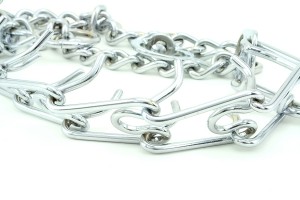You are here
It seems that these days the measure of your skill as a handler is dependent on the way you deliver a correction. So how do I deliver a correction?
Well it depends on the where I am in the world. In some parts of the world some devices like pinch collars are illegal in others e-collars are banned. So depending on where I am depends on what I can use. Some devices are better than others at delivering a precise message to your dog that it has just done something it doesn’t want to repeat. Delivering a correction is more complex than just causing pain. In 99% of the cases pain is not needed to send a clear message to your dog and should be avoided, simply because there are side effects to pain compliance. For example, a dog that is anticipating pain cowers and it looks awful to see a dog moping around.
Not giving your dog what it wants is by far the best way of correcting your dog. Let me explain. If your dog does something you don’t want it to do then it is not rewarded. Your dog will realize that what ever it just did does not lead to what it wants and will attempt something else which may lead to the reward. So how about punishing unwanted behavior? I just told you. Denying a reward is the punishment. The trick, if I can use that word, is to always be in a position to offer your dog something it wants. If you expect a positive response then you need to offer an incentive and you must let your dog know that the incentive will immediately become available upon the successful completion of your command.
If your boss paid you a year after you did your work then you would probably quit or at the very least be very casual with your performance. Your dog is the same. If your dog knows that it will be ‘paid’ immediately after the successful completion of the task it will be very focused and corrections will be unnecessary. Your dog will do exactly what you want – once you learn to communicate what you want your dog to do. That’s the hardest part of dog handling; communicating what it is you want your dog to do. But once you have done this, you will be truly amazed at how driven your dog is to get it right.
In Summary – The tools of correction you use are dependent on legislation in your area at the time. Understanding how to avoid correction is the difference between a good handler and a great handler. Every time you correct your dog with pain you chip away at its drive – which is the last thing you ever want to do to a K9.
Categories
- Bite Work (3)
- Breeding (16)
- Drills & Tactics (13)
- Drive (7)
- Equipment (2)
- General (17)
- K9 Health & Fitness (49)
- K9 Search and Rescue Training (4)
- Law (5)
- Must Read (9)
- Personal Security (7)
- Problem Solving (14)
- Socialization (6)
- Springer (5)
- Uncategorized (10)
Calendar
April 2024 M T W T F S S « Nov 1 2 3 4 5 6 7 8 9 10 11 12 13 14 15 16 17 18 19 20 21 22 23 24 25 26 27 28 29 30

